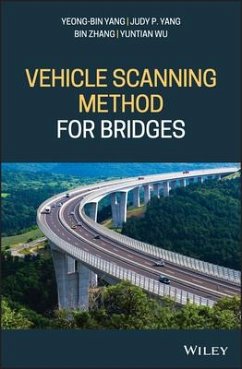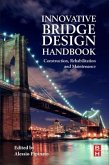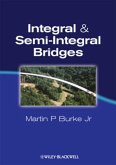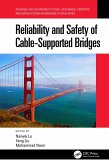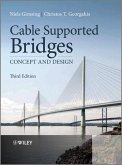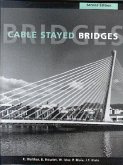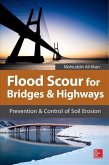Andere Kunden interessierten sich auch für
![Innovative Bridge Design Handbook Innovative Bridge Design Handbook]() Innovative Bridge Design Handbook99,99 €
Innovative Bridge Design Handbook99,99 €![Steel Connection Design by Inelastic Analysis Steel Connection Design by Inelastic Analysis]() Mark D DenavitSteel Connection Design by Inelastic Analysis110,99 €
Mark D DenavitSteel Connection Design by Inelastic Analysis110,99 €![Integral and Semi-Integral Bridges Integral and Semi-Integral Bridges]() Martin P Burke JrIntegral and Semi-Integral Bridges160,99 €
Martin P Burke JrIntegral and Semi-Integral Bridges160,99 €![Reliability and Safety of Cable-Supported Bridges Reliability and Safety of Cable-Supported Bridges]() Reliability and Safety of Cable-Supported Bridges153,99 €
Reliability and Safety of Cable-Supported Bridges153,99 €![Cable Supported Bridges Cable Supported Bridges]() Niels J. GimsingCable Supported Bridges226,99 €
Niels J. GimsingCable Supported Bridges226,99 €![Cable Stayed Bridges Cable Stayed Bridges]() Rene WaltherCable Stayed Bridges209,99 €
Rene WaltherCable Stayed Bridges209,99 €![Flood Scour for Bridges and Highways Flood Scour for Bridges and Highways]() Mohiuddin A KhanFlood Scour for Bridges and Highways180,99 €
Mohiuddin A KhanFlood Scour for Bridges and Highways180,99 €-
-
-
Produktdetails
- Verlag: Wiley
- Seitenzahl: 500
- Erscheinungstermin: 25. November 2019
- Englisch
- Abmessung: 246mm x 173mm x 20mm
- Gewicht: 576g
- ISBN-13: 9781119539582
- ISBN-10: 1119539587
- Artikelnr.: 57824995
Hinweis: Dieser Artikel kann nur an eine deutsche Lieferadresse ausgeliefert werden.
- Herstellerkennzeichnung
- Libri GmbH
- Europaallee 1
- 36244 Bad Hersfeld
- gpsr@libri.de
YEONG-BIN YANG, PHD, is Honorary Dean of Civil Engineering, Chongqing University in China, Feng Tay Chair Professor of National Yunlin University of Science and Technology (YunTech), and Professor Emeritus of National Taiwan University (NTU) in Taiwan. He is a member of the Chinese Academy of Engineering, Austrian Academy of Sciences, and EU Academy of Sciences. Also, he is an Editor-in-Chief of the International Journal of Structural Stability and Dynamics, President of the Asian-Pacific Association of Computational Mechanics (APACM), and Chairman of the East Asia-Pacific Conference on Structural Engineering and Construction (EASEC). JUDY P. YANG, PHD, is an Associate Professor in the Dept. of Civil Engineering, National Chiao Tung University, Taiwan. BIN ZHANG is a PhD student in the School of Civil Engineering, Chongqing University in China. YUNTIAN WU, PHD, is a Professor in the School of Civil Engineering, Chongqing University, China.
Preface ix Acknowledgments xiii 1 Introduction 1 1.1 Modal Properties of Bridges 1 1.2 Basic Concept of the Vehicle Scanning Method 3 1.2.1 Bridge Frequency Extraction 3 1.2.2 Bridge Mode Shapes Construction 4 1.3 Brief on the Works Conducted by Yang and CöWorkers 5 1.4 Works Done by Researchers Worldwide 7 1.4.1 Theoretical Analysis and Simulation 8 1.4.2 Laboratory Test 16 1.4.3 Field Investigation 20 1.5 Concluding Remarks 22 2 Vehicle Scanning of Bridge Frequencies: Simple Theory 25 2.1 Introduction 25 2.2 Formulation of the Analytical Theory 27 2.3 Single
Mode Analytical Solution 28 2.4 Condition of Resonance 34 2.5 Simulation by the Finite Element Method (FEM) 39 2.6 Verification of Accuracy of Analytical Solutions 41 2.7 Extraction of Fundamental Frequency of Bridge 42 2.7.1 Effect of Moving Speed of the Vehicle 46 2.7.2 Condition of Resonance 46 2.7.3 Effect of Damping of the Bridge 48 2.7.4 Effect of a Vehicle Traveling over a Stiffer Bridge 49 2.8 Concluding Remarks 50 3 Vehicle Scanning of Bridge Frequencies: General Theory 51 3.1 Introduction 51 3.2 Physical Modeling and Formulation 53 3.3 Dynamic Response of the Beam 55 3.3.1 Beam's Response to a Single Moving Vehicle 58 3.3.2 Beam's Response to Five Moving Vehicles 61 3.4 Dynamic Response of the Moving Vehicle 62 3.5 Numerical Verification 66 3.6 Concluding Remarks 69 4 Vehicle Scanning of Bridge Frequencies: Experiment 71 4.1 Introduction 71 4.2 Objective of This Chapter 72 4.3 Description of the Test Bridge 73 4.4 Description of the Test Vehicle 73 4.5 Instrumentation 75 4.6 Testing Plan 75 4.7 Eigenvalue Analysis Results 77 4.8 Experimental Results 77 4.8.1 Ambient Vibration Test 77 4.8.2 Vehicle Characteristics Test 78 4.8.3 Bridge Response to the Moving Truck 79 4.8.4 Response of the Test Cart Resting on the Bridge to the Moving Truck 81 4.8.5 Response of the Moving Test Cart with No Ongoing Traffic 83 4.8.6 Response of the Moving Test Cart with Ongoing Traffic 85 4.9 Comparing the Measured Results with Numerical Results 86 4.10 Concluding Remarks 87 5 EMD
Enhanced Vehicle Scanning of Bridge Frequencies 91 5.1 Introduction 91 5.2 Analytical Formulation of the Problem 93 5.3 Finite Element Simulation of the Problem 96 5.4 Empirical Mode Decomposition 97 5.5 Extraction of Bridge Frequencies by Numerical Simulation 99 5.5.1 Example 1: Single Moving Vehicle 101 5.5.2 Example 2: Five Sequential Moving Vehicles 102 5.5.3 Example 3: Five Random Moving Vehicles 105 5.6 Experimental Studies 105 5.7 Concluding Remarks 114 6 Effect of Road Roughness on Extraction of Bridge Frequencies 115 6.1 Introduction 115 6.2 Simulation of Roughness Profiles 116 6.3 Simulation of Bridges with Rough Surface 117 6.4 Effect of Road Roughness on Vehicle Response 118 6.4.1 Case 1: Vehicle Frequency Less than Any Bridge Frequencies 119 6.4.2 Case 2: Vehicle Frequency Greater than the First Bridge Frequency 119 6.5 Vehicle Responses Induced by Separate Excitational Sources 122 6.6 Closed
Form Solution of Vehicle Response Considering Road Roughness 122 6.7 Reducing the Impact of Road Roughness by Using Two Connected Vehicles 127 6.8 Numerical Studies 131 6.8.1 Example 1. Two Identical Vehicles Moving over the Bridge of Class A Roughness 131 6.8.2 Example 2. Two Identical Vehicles Moving over the Bridge of Class C Roughness 131 6.8.3 Example 3. Two Vehicles of Identical Frequency but Different Properties 132 6.8.4 Effect of Vehicle Spacing on Identification of Bridge Frequencies 133 6.9 Concluding Remarks 135 7 Filtering Technique for Eliminating the Effect of Road Roughness 137 7.1 Introduction 137 7.2 Numerical Simulations for Vehicle Responses 138 7.3 Filtering Techniques 141 7.3.1 Band
Pass Filter (BPF)/Band
Stop Filter (BSF) 141 7.3.2 Singular Spectrum Analysis (SSA) 142 7.3.3 Singular Spectrum Analysis with Band
Pass Filter (SSA
BPF) 144 7.4 Case Studies 145 7.4.1 Case 1: Vehicle Frequency Smaller than First Bridge Frequency 145 7.4.2 Case 2: Vehicle Frequency Greater than First Bridge Frequency 148 7.5 Concluding Remarks 151 8 Hand
Drawn Cart Used to Measure Bridge Frequencies 153 8.1 Introduction 153 8.2 Dynamic Properties of the Hand
Drawn Test Cart 156 8.3 Basic Dynamic Tests for the Test Cart 157 8.4 Field Tests 162 8.4.1 Effect of Cart Weight 163 8.4.2 Effect of Various Traveling Speeds 165 8.4.3 Various Volumes of Existing Traffic Flows 170 8.5 Concluding Remarks 173 9 Theory for Retrieving Bridge Mode Shapes 175 9.1 Introduction 175 9.2 Hilbert Transformation 176 9.3 Theoretical Formulation 177 9.4 Algorithms and Constraints 181 9.5 Case Studies 185 9.5.1 Test Vehicle Passing through a Bridge with Smooth Road Surface 186 9.5.2 Effect of Vehicle Speed 187 9.5.3 Test Vehicle Traveling along with Random Traffic 190 9.5.4 Effect of Road Surface Roughness 190 9.6 Concluding Remarks 193 10 Contact
Point Response for Modal Identification of Bridges 195 10.1 Introduction 195 10.2 Theoretical Formulation 197 10.2.1 Dynamic Response of the Vehicle
Bridge Contact Point 198 10.2.2 Dynamic Response of the Moving Vehicle 199 10.2.3 Procedure for Calculating the Contact
Point Response in a Field Test 201 10.2.4 Relationship Between the Contact
Point and Vehicle Responses 201 10.3 Finite Element Simulation of VBI Problems 204 10.3.1 Brief on VBI Element 204 10.3.2 Verification of the Theoretical Solution 205 10.4 Retrieval of Bridge Frequencies 206 10.5 Retrieval of Bridge Mode Shapes 208 10.5.1 Effect of Moving Speed 209 10.5.2 Effect of Vehicle Frequency 210 10.6 Effect of Road Roughness 212 10.6.1 Bridge with Rough Surface Free of Existing Traffic 212 10.6.2 Bridge with Rough Surface under Existing Traffic 214 10.7 Concluding Remarks 215 11 Damage Detection of Bridges Using the Contact
Point Response 217 11.1 Introduction 217 11.2 Dynamic Response of the Vehicle
Bridge System 219 11.2.1 Contact
Point Response: Analytical Solution 220 11.2.2 Contact
Point Response: For Use in Field Test 220 11.3 Algorithm for Damage Detection 221 11.3.1 Hilbert Transformation 221 11.3.2 Strategy for Damage Detection 221 11.4 Finite Element Simulation of the Problem 223 11.4.1 Damage Element for Beams 223 11.4.2 Brief on Vehicle
Bridge Interaction (VBI) Element Used 224 11.5 Detection of Damages on a Beam 225 11.5.1 Detection of Damage Location on the Beam 225 11.5.2 Detection of Damage Severity 226 11.5.3 Detection of Multiple Damages 228 11.6 Parametric Study 228 11.6.1 Effect of Test Vehicle Speed 229 11.6.2 Effect of Measurement Noise 229 11.6.3 Bridge with Rough Surface Free of Random Traffic 230 11.6.4 Bridge with Rough Surface under Random Traffic 232 11.7 Concluding Remarks 234 Appendix: Finite Element Simulation 237 References 247 Author Index 259 Subject Index 265
Mode Analytical Solution 28 2.4 Condition of Resonance 34 2.5 Simulation by the Finite Element Method (FEM) 39 2.6 Verification of Accuracy of Analytical Solutions 41 2.7 Extraction of Fundamental Frequency of Bridge 42 2.7.1 Effect of Moving Speed of the Vehicle 46 2.7.2 Condition of Resonance 46 2.7.3 Effect of Damping of the Bridge 48 2.7.4 Effect of a Vehicle Traveling over a Stiffer Bridge 49 2.8 Concluding Remarks 50 3 Vehicle Scanning of Bridge Frequencies: General Theory 51 3.1 Introduction 51 3.2 Physical Modeling and Formulation 53 3.3 Dynamic Response of the Beam 55 3.3.1 Beam's Response to a Single Moving Vehicle 58 3.3.2 Beam's Response to Five Moving Vehicles 61 3.4 Dynamic Response of the Moving Vehicle 62 3.5 Numerical Verification 66 3.6 Concluding Remarks 69 4 Vehicle Scanning of Bridge Frequencies: Experiment 71 4.1 Introduction 71 4.2 Objective of This Chapter 72 4.3 Description of the Test Bridge 73 4.4 Description of the Test Vehicle 73 4.5 Instrumentation 75 4.6 Testing Plan 75 4.7 Eigenvalue Analysis Results 77 4.8 Experimental Results 77 4.8.1 Ambient Vibration Test 77 4.8.2 Vehicle Characteristics Test 78 4.8.3 Bridge Response to the Moving Truck 79 4.8.4 Response of the Test Cart Resting on the Bridge to the Moving Truck 81 4.8.5 Response of the Moving Test Cart with No Ongoing Traffic 83 4.8.6 Response of the Moving Test Cart with Ongoing Traffic 85 4.9 Comparing the Measured Results with Numerical Results 86 4.10 Concluding Remarks 87 5 EMD
Enhanced Vehicle Scanning of Bridge Frequencies 91 5.1 Introduction 91 5.2 Analytical Formulation of the Problem 93 5.3 Finite Element Simulation of the Problem 96 5.4 Empirical Mode Decomposition 97 5.5 Extraction of Bridge Frequencies by Numerical Simulation 99 5.5.1 Example 1: Single Moving Vehicle 101 5.5.2 Example 2: Five Sequential Moving Vehicles 102 5.5.3 Example 3: Five Random Moving Vehicles 105 5.6 Experimental Studies 105 5.7 Concluding Remarks 114 6 Effect of Road Roughness on Extraction of Bridge Frequencies 115 6.1 Introduction 115 6.2 Simulation of Roughness Profiles 116 6.3 Simulation of Bridges with Rough Surface 117 6.4 Effect of Road Roughness on Vehicle Response 118 6.4.1 Case 1: Vehicle Frequency Less than Any Bridge Frequencies 119 6.4.2 Case 2: Vehicle Frequency Greater than the First Bridge Frequency 119 6.5 Vehicle Responses Induced by Separate Excitational Sources 122 6.6 Closed
Form Solution of Vehicle Response Considering Road Roughness 122 6.7 Reducing the Impact of Road Roughness by Using Two Connected Vehicles 127 6.8 Numerical Studies 131 6.8.1 Example 1. Two Identical Vehicles Moving over the Bridge of Class A Roughness 131 6.8.2 Example 2. Two Identical Vehicles Moving over the Bridge of Class C Roughness 131 6.8.3 Example 3. Two Vehicles of Identical Frequency but Different Properties 132 6.8.4 Effect of Vehicle Spacing on Identification of Bridge Frequencies 133 6.9 Concluding Remarks 135 7 Filtering Technique for Eliminating the Effect of Road Roughness 137 7.1 Introduction 137 7.2 Numerical Simulations for Vehicle Responses 138 7.3 Filtering Techniques 141 7.3.1 Band
Pass Filter (BPF)/Band
Stop Filter (BSF) 141 7.3.2 Singular Spectrum Analysis (SSA) 142 7.3.3 Singular Spectrum Analysis with Band
Pass Filter (SSA
BPF) 144 7.4 Case Studies 145 7.4.1 Case 1: Vehicle Frequency Smaller than First Bridge Frequency 145 7.4.2 Case 2: Vehicle Frequency Greater than First Bridge Frequency 148 7.5 Concluding Remarks 151 8 Hand
Drawn Cart Used to Measure Bridge Frequencies 153 8.1 Introduction 153 8.2 Dynamic Properties of the Hand
Drawn Test Cart 156 8.3 Basic Dynamic Tests for the Test Cart 157 8.4 Field Tests 162 8.4.1 Effect of Cart Weight 163 8.4.2 Effect of Various Traveling Speeds 165 8.4.3 Various Volumes of Existing Traffic Flows 170 8.5 Concluding Remarks 173 9 Theory for Retrieving Bridge Mode Shapes 175 9.1 Introduction 175 9.2 Hilbert Transformation 176 9.3 Theoretical Formulation 177 9.4 Algorithms and Constraints 181 9.5 Case Studies 185 9.5.1 Test Vehicle Passing through a Bridge with Smooth Road Surface 186 9.5.2 Effect of Vehicle Speed 187 9.5.3 Test Vehicle Traveling along with Random Traffic 190 9.5.4 Effect of Road Surface Roughness 190 9.6 Concluding Remarks 193 10 Contact
Point Response for Modal Identification of Bridges 195 10.1 Introduction 195 10.2 Theoretical Formulation 197 10.2.1 Dynamic Response of the Vehicle
Bridge Contact Point 198 10.2.2 Dynamic Response of the Moving Vehicle 199 10.2.3 Procedure for Calculating the Contact
Point Response in a Field Test 201 10.2.4 Relationship Between the Contact
Point and Vehicle Responses 201 10.3 Finite Element Simulation of VBI Problems 204 10.3.1 Brief on VBI Element 204 10.3.2 Verification of the Theoretical Solution 205 10.4 Retrieval of Bridge Frequencies 206 10.5 Retrieval of Bridge Mode Shapes 208 10.5.1 Effect of Moving Speed 209 10.5.2 Effect of Vehicle Frequency 210 10.6 Effect of Road Roughness 212 10.6.1 Bridge with Rough Surface Free of Existing Traffic 212 10.6.2 Bridge with Rough Surface under Existing Traffic 214 10.7 Concluding Remarks 215 11 Damage Detection of Bridges Using the Contact
Point Response 217 11.1 Introduction 217 11.2 Dynamic Response of the Vehicle
Bridge System 219 11.2.1 Contact
Point Response: Analytical Solution 220 11.2.2 Contact
Point Response: For Use in Field Test 220 11.3 Algorithm for Damage Detection 221 11.3.1 Hilbert Transformation 221 11.3.2 Strategy for Damage Detection 221 11.4 Finite Element Simulation of the Problem 223 11.4.1 Damage Element for Beams 223 11.4.2 Brief on Vehicle
Bridge Interaction (VBI) Element Used 224 11.5 Detection of Damages on a Beam 225 11.5.1 Detection of Damage Location on the Beam 225 11.5.2 Detection of Damage Severity 226 11.5.3 Detection of Multiple Damages 228 11.6 Parametric Study 228 11.6.1 Effect of Test Vehicle Speed 229 11.6.2 Effect of Measurement Noise 229 11.6.3 Bridge with Rough Surface Free of Random Traffic 230 11.6.4 Bridge with Rough Surface under Random Traffic 232 11.7 Concluding Remarks 234 Appendix: Finite Element Simulation 237 References 247 Author Index 259 Subject Index 265
Preface ix Acknowledgments xiii 1 Introduction 1 1.1 Modal Properties of Bridges 1 1.2 Basic Concept of the Vehicle Scanning Method 3 1.2.1 Bridge Frequency Extraction 3 1.2.2 Bridge Mode Shapes Construction 4 1.3 Brief on the Works Conducted by Yang and CöWorkers 5 1.4 Works Done by Researchers Worldwide 7 1.4.1 Theoretical Analysis and Simulation 8 1.4.2 Laboratory Test 16 1.4.3 Field Investigation 20 1.5 Concluding Remarks 22 2 Vehicle Scanning of Bridge Frequencies: Simple Theory 25 2.1 Introduction 25 2.2 Formulation of the Analytical Theory 27 2.3 Single
Mode Analytical Solution 28 2.4 Condition of Resonance 34 2.5 Simulation by the Finite Element Method (FEM) 39 2.6 Verification of Accuracy of Analytical Solutions 41 2.7 Extraction of Fundamental Frequency of Bridge 42 2.7.1 Effect of Moving Speed of the Vehicle 46 2.7.2 Condition of Resonance 46 2.7.3 Effect of Damping of the Bridge 48 2.7.4 Effect of a Vehicle Traveling over a Stiffer Bridge 49 2.8 Concluding Remarks 50 3 Vehicle Scanning of Bridge Frequencies: General Theory 51 3.1 Introduction 51 3.2 Physical Modeling and Formulation 53 3.3 Dynamic Response of the Beam 55 3.3.1 Beam's Response to a Single Moving Vehicle 58 3.3.2 Beam's Response to Five Moving Vehicles 61 3.4 Dynamic Response of the Moving Vehicle 62 3.5 Numerical Verification 66 3.6 Concluding Remarks 69 4 Vehicle Scanning of Bridge Frequencies: Experiment 71 4.1 Introduction 71 4.2 Objective of This Chapter 72 4.3 Description of the Test Bridge 73 4.4 Description of the Test Vehicle 73 4.5 Instrumentation 75 4.6 Testing Plan 75 4.7 Eigenvalue Analysis Results 77 4.8 Experimental Results 77 4.8.1 Ambient Vibration Test 77 4.8.2 Vehicle Characteristics Test 78 4.8.3 Bridge Response to the Moving Truck 79 4.8.4 Response of the Test Cart Resting on the Bridge to the Moving Truck 81 4.8.5 Response of the Moving Test Cart with No Ongoing Traffic 83 4.8.6 Response of the Moving Test Cart with Ongoing Traffic 85 4.9 Comparing the Measured Results with Numerical Results 86 4.10 Concluding Remarks 87 5 EMD
Enhanced Vehicle Scanning of Bridge Frequencies 91 5.1 Introduction 91 5.2 Analytical Formulation of the Problem 93 5.3 Finite Element Simulation of the Problem 96 5.4 Empirical Mode Decomposition 97 5.5 Extraction of Bridge Frequencies by Numerical Simulation 99 5.5.1 Example 1: Single Moving Vehicle 101 5.5.2 Example 2: Five Sequential Moving Vehicles 102 5.5.3 Example 3: Five Random Moving Vehicles 105 5.6 Experimental Studies 105 5.7 Concluding Remarks 114 6 Effect of Road Roughness on Extraction of Bridge Frequencies 115 6.1 Introduction 115 6.2 Simulation of Roughness Profiles 116 6.3 Simulation of Bridges with Rough Surface 117 6.4 Effect of Road Roughness on Vehicle Response 118 6.4.1 Case 1: Vehicle Frequency Less than Any Bridge Frequencies 119 6.4.2 Case 2: Vehicle Frequency Greater than the First Bridge Frequency 119 6.5 Vehicle Responses Induced by Separate Excitational Sources 122 6.6 Closed
Form Solution of Vehicle Response Considering Road Roughness 122 6.7 Reducing the Impact of Road Roughness by Using Two Connected Vehicles 127 6.8 Numerical Studies 131 6.8.1 Example 1. Two Identical Vehicles Moving over the Bridge of Class A Roughness 131 6.8.2 Example 2. Two Identical Vehicles Moving over the Bridge of Class C Roughness 131 6.8.3 Example 3. Two Vehicles of Identical Frequency but Different Properties 132 6.8.4 Effect of Vehicle Spacing on Identification of Bridge Frequencies 133 6.9 Concluding Remarks 135 7 Filtering Technique for Eliminating the Effect of Road Roughness 137 7.1 Introduction 137 7.2 Numerical Simulations for Vehicle Responses 138 7.3 Filtering Techniques 141 7.3.1 Band
Pass Filter (BPF)/Band
Stop Filter (BSF) 141 7.3.2 Singular Spectrum Analysis (SSA) 142 7.3.3 Singular Spectrum Analysis with Band
Pass Filter (SSA
BPF) 144 7.4 Case Studies 145 7.4.1 Case 1: Vehicle Frequency Smaller than First Bridge Frequency 145 7.4.2 Case 2: Vehicle Frequency Greater than First Bridge Frequency 148 7.5 Concluding Remarks 151 8 Hand
Drawn Cart Used to Measure Bridge Frequencies 153 8.1 Introduction 153 8.2 Dynamic Properties of the Hand
Drawn Test Cart 156 8.3 Basic Dynamic Tests for the Test Cart 157 8.4 Field Tests 162 8.4.1 Effect of Cart Weight 163 8.4.2 Effect of Various Traveling Speeds 165 8.4.3 Various Volumes of Existing Traffic Flows 170 8.5 Concluding Remarks 173 9 Theory for Retrieving Bridge Mode Shapes 175 9.1 Introduction 175 9.2 Hilbert Transformation 176 9.3 Theoretical Formulation 177 9.4 Algorithms and Constraints 181 9.5 Case Studies 185 9.5.1 Test Vehicle Passing through a Bridge with Smooth Road Surface 186 9.5.2 Effect of Vehicle Speed 187 9.5.3 Test Vehicle Traveling along with Random Traffic 190 9.5.4 Effect of Road Surface Roughness 190 9.6 Concluding Remarks 193 10 Contact
Point Response for Modal Identification of Bridges 195 10.1 Introduction 195 10.2 Theoretical Formulation 197 10.2.1 Dynamic Response of the Vehicle
Bridge Contact Point 198 10.2.2 Dynamic Response of the Moving Vehicle 199 10.2.3 Procedure for Calculating the Contact
Point Response in a Field Test 201 10.2.4 Relationship Between the Contact
Point and Vehicle Responses 201 10.3 Finite Element Simulation of VBI Problems 204 10.3.1 Brief on VBI Element 204 10.3.2 Verification of the Theoretical Solution 205 10.4 Retrieval of Bridge Frequencies 206 10.5 Retrieval of Bridge Mode Shapes 208 10.5.1 Effect of Moving Speed 209 10.5.2 Effect of Vehicle Frequency 210 10.6 Effect of Road Roughness 212 10.6.1 Bridge with Rough Surface Free of Existing Traffic 212 10.6.2 Bridge with Rough Surface under Existing Traffic 214 10.7 Concluding Remarks 215 11 Damage Detection of Bridges Using the Contact
Point Response 217 11.1 Introduction 217 11.2 Dynamic Response of the Vehicle
Bridge System 219 11.2.1 Contact
Point Response: Analytical Solution 220 11.2.2 Contact
Point Response: For Use in Field Test 220 11.3 Algorithm for Damage Detection 221 11.3.1 Hilbert Transformation 221 11.3.2 Strategy for Damage Detection 221 11.4 Finite Element Simulation of the Problem 223 11.4.1 Damage Element for Beams 223 11.4.2 Brief on Vehicle
Bridge Interaction (VBI) Element Used 224 11.5 Detection of Damages on a Beam 225 11.5.1 Detection of Damage Location on the Beam 225 11.5.2 Detection of Damage Severity 226 11.5.3 Detection of Multiple Damages 228 11.6 Parametric Study 228 11.6.1 Effect of Test Vehicle Speed 229 11.6.2 Effect of Measurement Noise 229 11.6.3 Bridge with Rough Surface Free of Random Traffic 230 11.6.4 Bridge with Rough Surface under Random Traffic 232 11.7 Concluding Remarks 234 Appendix: Finite Element Simulation 237 References 247 Author Index 259 Subject Index 265
Mode Analytical Solution 28 2.4 Condition of Resonance 34 2.5 Simulation by the Finite Element Method (FEM) 39 2.6 Verification of Accuracy of Analytical Solutions 41 2.7 Extraction of Fundamental Frequency of Bridge 42 2.7.1 Effect of Moving Speed of the Vehicle 46 2.7.2 Condition of Resonance 46 2.7.3 Effect of Damping of the Bridge 48 2.7.4 Effect of a Vehicle Traveling over a Stiffer Bridge 49 2.8 Concluding Remarks 50 3 Vehicle Scanning of Bridge Frequencies: General Theory 51 3.1 Introduction 51 3.2 Physical Modeling and Formulation 53 3.3 Dynamic Response of the Beam 55 3.3.1 Beam's Response to a Single Moving Vehicle 58 3.3.2 Beam's Response to Five Moving Vehicles 61 3.4 Dynamic Response of the Moving Vehicle 62 3.5 Numerical Verification 66 3.6 Concluding Remarks 69 4 Vehicle Scanning of Bridge Frequencies: Experiment 71 4.1 Introduction 71 4.2 Objective of This Chapter 72 4.3 Description of the Test Bridge 73 4.4 Description of the Test Vehicle 73 4.5 Instrumentation 75 4.6 Testing Plan 75 4.7 Eigenvalue Analysis Results 77 4.8 Experimental Results 77 4.8.1 Ambient Vibration Test 77 4.8.2 Vehicle Characteristics Test 78 4.8.3 Bridge Response to the Moving Truck 79 4.8.4 Response of the Test Cart Resting on the Bridge to the Moving Truck 81 4.8.5 Response of the Moving Test Cart with No Ongoing Traffic 83 4.8.6 Response of the Moving Test Cart with Ongoing Traffic 85 4.9 Comparing the Measured Results with Numerical Results 86 4.10 Concluding Remarks 87 5 EMD
Enhanced Vehicle Scanning of Bridge Frequencies 91 5.1 Introduction 91 5.2 Analytical Formulation of the Problem 93 5.3 Finite Element Simulation of the Problem 96 5.4 Empirical Mode Decomposition 97 5.5 Extraction of Bridge Frequencies by Numerical Simulation 99 5.5.1 Example 1: Single Moving Vehicle 101 5.5.2 Example 2: Five Sequential Moving Vehicles 102 5.5.3 Example 3: Five Random Moving Vehicles 105 5.6 Experimental Studies 105 5.7 Concluding Remarks 114 6 Effect of Road Roughness on Extraction of Bridge Frequencies 115 6.1 Introduction 115 6.2 Simulation of Roughness Profiles 116 6.3 Simulation of Bridges with Rough Surface 117 6.4 Effect of Road Roughness on Vehicle Response 118 6.4.1 Case 1: Vehicle Frequency Less than Any Bridge Frequencies 119 6.4.2 Case 2: Vehicle Frequency Greater than the First Bridge Frequency 119 6.5 Vehicle Responses Induced by Separate Excitational Sources 122 6.6 Closed
Form Solution of Vehicle Response Considering Road Roughness 122 6.7 Reducing the Impact of Road Roughness by Using Two Connected Vehicles 127 6.8 Numerical Studies 131 6.8.1 Example 1. Two Identical Vehicles Moving over the Bridge of Class A Roughness 131 6.8.2 Example 2. Two Identical Vehicles Moving over the Bridge of Class C Roughness 131 6.8.3 Example 3. Two Vehicles of Identical Frequency but Different Properties 132 6.8.4 Effect of Vehicle Spacing on Identification of Bridge Frequencies 133 6.9 Concluding Remarks 135 7 Filtering Technique for Eliminating the Effect of Road Roughness 137 7.1 Introduction 137 7.2 Numerical Simulations for Vehicle Responses 138 7.3 Filtering Techniques 141 7.3.1 Band
Pass Filter (BPF)/Band
Stop Filter (BSF) 141 7.3.2 Singular Spectrum Analysis (SSA) 142 7.3.3 Singular Spectrum Analysis with Band
Pass Filter (SSA
BPF) 144 7.4 Case Studies 145 7.4.1 Case 1: Vehicle Frequency Smaller than First Bridge Frequency 145 7.4.2 Case 2: Vehicle Frequency Greater than First Bridge Frequency 148 7.5 Concluding Remarks 151 8 Hand
Drawn Cart Used to Measure Bridge Frequencies 153 8.1 Introduction 153 8.2 Dynamic Properties of the Hand
Drawn Test Cart 156 8.3 Basic Dynamic Tests for the Test Cart 157 8.4 Field Tests 162 8.4.1 Effect of Cart Weight 163 8.4.2 Effect of Various Traveling Speeds 165 8.4.3 Various Volumes of Existing Traffic Flows 170 8.5 Concluding Remarks 173 9 Theory for Retrieving Bridge Mode Shapes 175 9.1 Introduction 175 9.2 Hilbert Transformation 176 9.3 Theoretical Formulation 177 9.4 Algorithms and Constraints 181 9.5 Case Studies 185 9.5.1 Test Vehicle Passing through a Bridge with Smooth Road Surface 186 9.5.2 Effect of Vehicle Speed 187 9.5.3 Test Vehicle Traveling along with Random Traffic 190 9.5.4 Effect of Road Surface Roughness 190 9.6 Concluding Remarks 193 10 Contact
Point Response for Modal Identification of Bridges 195 10.1 Introduction 195 10.2 Theoretical Formulation 197 10.2.1 Dynamic Response of the Vehicle
Bridge Contact Point 198 10.2.2 Dynamic Response of the Moving Vehicle 199 10.2.3 Procedure for Calculating the Contact
Point Response in a Field Test 201 10.2.4 Relationship Between the Contact
Point and Vehicle Responses 201 10.3 Finite Element Simulation of VBI Problems 204 10.3.1 Brief on VBI Element 204 10.3.2 Verification of the Theoretical Solution 205 10.4 Retrieval of Bridge Frequencies 206 10.5 Retrieval of Bridge Mode Shapes 208 10.5.1 Effect of Moving Speed 209 10.5.2 Effect of Vehicle Frequency 210 10.6 Effect of Road Roughness 212 10.6.1 Bridge with Rough Surface Free of Existing Traffic 212 10.6.2 Bridge with Rough Surface under Existing Traffic 214 10.7 Concluding Remarks 215 11 Damage Detection of Bridges Using the Contact
Point Response 217 11.1 Introduction 217 11.2 Dynamic Response of the Vehicle
Bridge System 219 11.2.1 Contact
Point Response: Analytical Solution 220 11.2.2 Contact
Point Response: For Use in Field Test 220 11.3 Algorithm for Damage Detection 221 11.3.1 Hilbert Transformation 221 11.3.2 Strategy for Damage Detection 221 11.4 Finite Element Simulation of the Problem 223 11.4.1 Damage Element for Beams 223 11.4.2 Brief on Vehicle
Bridge Interaction (VBI) Element Used 224 11.5 Detection of Damages on a Beam 225 11.5.1 Detection of Damage Location on the Beam 225 11.5.2 Detection of Damage Severity 226 11.5.3 Detection of Multiple Damages 228 11.6 Parametric Study 228 11.6.1 Effect of Test Vehicle Speed 229 11.6.2 Effect of Measurement Noise 229 11.6.3 Bridge with Rough Surface Free of Random Traffic 230 11.6.4 Bridge with Rough Surface under Random Traffic 232 11.7 Concluding Remarks 234 Appendix: Finite Element Simulation 237 References 247 Author Index 259 Subject Index 265

